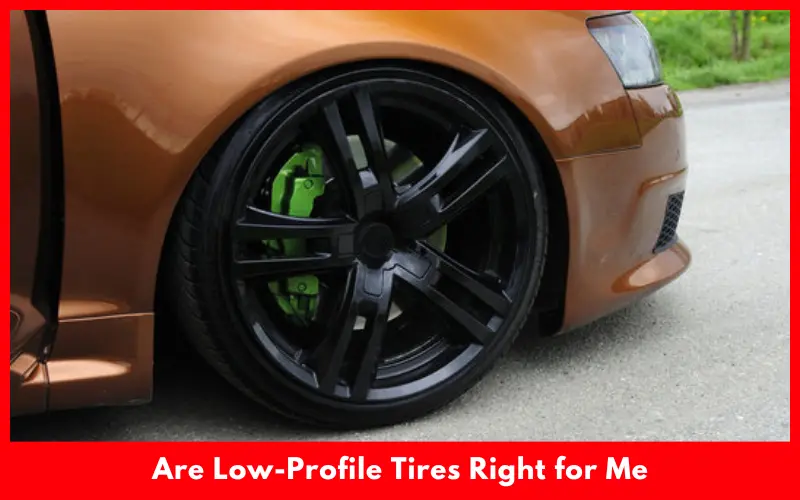While low-profile tires have been used successfully in race tracks for many years now, you’re starting to see them more and more often on the street.
With shorter sidewalls and often wider treads, low profile tires have a look that adds an aggressive edge to any kind of vehicle. Read on to learn what low-profile tires are, and what the differences are with standard tires.
Article Summary
What are Low Profile Tires?
Low-profile’ tires are characterised by their ‘aspect ratio’ the ratio of the height of the sidewall of the tire to the width of the sidewall. The aspect ratio is always branded (pun intended) on the side of your tire.
For example, 225/45R17 means the width of your tire is 225 millimeters, and the aspect ratio is 45. Tires with an aspect ratio below 50 are generally considered low-profile and, as you might have guessed, low-profile tires have a shorter sidewall and a broader tread.
Low Profile Tires vs Standard Tires
Performance
Wider tread block and lower sidewall (through low-profile tires) will create more precise steering and contact grip, especially in cornering, paired up with a wide rim, like 22 inch rims, which combines the bigger than usual brake disc in a car for speed checking and more responsive braking system than periodic brakes when speed is increasing.
Visual appeal
Low-profile tyres make vehicles look sleek, modern and sporty, which is popular among car-enthusiasts. They give the car a more aggressive stance and play up its performance appearance. The look is typically matched with oversized rims that carry special-effect designs in the spokes and fancy finishes.
Road Feedback
With these low-profile tires, drivers get more feel of the driving surface. However, they are designed to be used in a race track that usually has hexagonal surfaces rather than rough debris such as gravel. So it might work better in a sports car than an off-road car.
Sound
Lower sidewall heights indicate less padding to absorb road vibrations. Stiffer construction and tread-pattern designs sometimes generate more road noise than standard-profile tires. On the other hand, Bridgestone’s Turanza QuietTrack low-profile tyres are designed to be quieter than ordinary low-profiles.
Durability
The low sidewalls attached to stiff construction of low-profile tyres make them more vulnerable to damage from potholes, curbs and road debris. Many low-profile tyres are built from softer rubber compounds to improve handling and reduce lapping, which results in faster wear than the usual tyres.
Are Low-Profile Tires Right for Me?
In general, if you drive in an environment that has more smooth, easy surfaces, such as track racing, or are an urban driver in dense cities with decent roads and highways, those low-profile tires will have a lot to offer in terms of benefits.

However, the drivers who will find it not so comfortable in low-profiles are those who are more prone to experiencing rough roads in overgrown cities.
Low-profile tyres appear to be a good fit for performance cars. That is because handling and performance are more important than ride comfort, durability or cost. When driving a sports car, improved stability, handling and grip are very important.
Low- profile tyres also make sense for luxury models. Luxury cars also offer better handling and ride quality so having tires that look sophisticated and customized make a lot of sense.
Choosing The Right Tires
Just like the regular tires you currently have on your car, not all low-profile tyres are created equal. Some will provide you with a more comfortable ride, while others will be more oriented towards performance and handling.
Identify where you are on the spectrum between performance and comfort, especially if most of your driving is done around town. Read user reviews and tire ratings and narrow down your tyre model. Write a response
Competition guidelines dictate what set-up you can or should use in various conditions, but your rubber choice can drastically impact performance. Tread pattern (grooves vs flat rubber) and rubber compound (sticky vs hard) of a low-profile tyre will affect its ability to grip in various conditions.
If you live in an area prone to rain and snow, an aggressive tread pattern will offer better traction. For a dry, high-speed track, smoother treads will suit you better. All-season low-profile tyres, such as the Michelin Pilot Sport All Season 4, are a good compromise between the two ends of the spectrum.
Choosing The Right Rims
The low-profile tyre usually combines with rims that have a diameter between 18 inches and over 22 inches, depending on the vehicle. Rim size must match the tyre in order to have adequate fitment.
At the same time, the width of the rim should complement the width of the tyre to ensure a contact patch with the road and to prevent problems such as over-stretch.
As far as the material for low profile tires, the most popular choice would be aluminum alloy rims, especially for a lightweight and good handling, because aluminum alloy rims could enhance heat diapating and guess what luxury and high-performance cars always want to drive fast with excellent handling.
If you want to have one of the best performance, forged aluminum wheels would be your nice choice because of the best strength/weight ratio by forging.
Obviously, looks matter most of all in rim choice, with multi-spoke, mesh and split-spoke designs lending a contemporary racing feel, with chrome, gunmetal and matte black finishes adding manly coolness that only serves to emphasise the vehicular charms on show. Browse the range online and you will find.
Conclusion
Low-profile tires are quite beneficial for one, it is easy to handle and also adds striking beauty to sporty vehicles and up-market cars. However, having all these benefits come with a price to pay, which includes having a rougher ride and also running the risk of replacing them more often.
This is why when everyone is contemplating on installing low-profile tires, the driving condition or style must always be the priority.

